Dependence of the Index of Biologically Active Ultraviolet Radiation on the Season and Time of Day
Abstract
:1. Introduction
2. Data
3. Results and Discussion
Compiling a Composite Year
4. Conclusions
Author Contributions
Funding
Institutional Review Board Statement
Informed Consent Statement
Data Availability Statement
Acknowledgments
Conflicts of Interest
References
- Lyman, D. Undiagnosed vitamin D deficiency in the hospitalized patient. Am. Fam. Physician 2005, 71, 299–304. [Google Scholar]
- Ghosh, A.K.; Joshi, S. Disorders of calcium, phosphorus and magnesium metabolism. Japi 2008, 56, 613–621. [Google Scholar]
- Hart, P.H.; Gorman, S.; Finlay-Jones, J.J. Modulation of the immune system by UV radiation: More than just the effects of vitamin D? Nat. Rev. Immunol. 2011, 11, 584–596. [Google Scholar]
- Wang, X.; Zhang, Z.; Wu, S.C. Health benefits of Silybum marianum: Phytochemistry, pharmacology, and applications. J. Agric. Food Chem. 2020, 68, 11644–11664. [Google Scholar]
- Liu, D.; Fernandez, B.O.; Hamilton, A.; Lang, N.N.; Gallagher, J.M.; Newby, D.E.; Feelisch, M.; Weller, R.B. UVA irradiation of human skin vasodilates arterial vasculature and lowers blood pressure independently of nitric oxide synthase. J. Investig. Dermatol. 2014, 134, 1839–1846. [Google Scholar]
- Ponsonby, A.L.; McMichael, A.; Van Der Mei, I. Ultraviolet radiation and autoimmune disease: Insights from epidemiological research. Toxicology 2002, 181, 71–78. [Google Scholar]
- Barbhaiya, M.; Costenbader, K.H. Ultraviolet radiation and systemic lupus erythematosus. Lupus 2014, 23, 588–595. [Google Scholar]
- Artuković, M.; Ikić, M.; Kuštelega, J.; Artuković, I.N.; Kaliterna, D.M. Influence of UV radiation on immunological system and occurrence of autoimmune diseases. Coll. Antropol. 2010, 34, 175–178. [Google Scholar]
- D’Orazio, J.; Jarrett, S.; Amaro-Ortiz, A.; Scott, T. UV radiation and the skin. Int. J. Mol. Sci. 2013, 14, 12222–12248. [Google Scholar]
- Coelho, S.G.; Choi, W.; Brenner, M.; Miyamura, Y.; Yamaguchi, Y.; Wolber, R.; Smuda, C.; Batzer, J.; Kolbe, L.; Ito, S.; et al. Short-and long-term effects of UV radiation on the pigmentation of human skin. J. Investig. Dermatol. Symp. Proc. 2009, 14, 32–35. [Google Scholar]
- De Gruijl, F.R. Skin cancer and solar UV radiation. Eur. J. Cancer 1999, 35, 2003–2009. [Google Scholar]
- Kaleyna, P.; Muhtarov, P.; Miloshev, N. Condition of the stratospheric and mesospheric ozone layer over Bulgaria for the period 1996–2012: Part 1—total ozone content, seasonal variations. Bulg. Geophys. J. 2013, 39, 9–16. [Google Scholar]
- Kaleyna, P.; Muhtarov, P.; Miloshev, N. Condition of the stratospheric and mesospheric ozone layer over Bulgaria for the period 1996–2012, Part 2: Total ozone content, short term variations. Bulg. Geophys. J. 2013, 39, 17–25. [Google Scholar]
- Vanicek, K.; Frei, T.; Litynska, Z.; Schmalwieser, A. UV-Index for the Public; Publication of the European Communities: Brussels, Belgium, 2000. [Google Scholar]
- Hall, E.S. Comparison of five modeling approaches to quantify and estimate the effect of clouds on the Radiation Amplification Factor (RAF) for solar ultraviolet radiation. Atmosphere 2017, 8, 153. [Google Scholar]
- Madronich, S.; McKenzie, R.L.; Björn, L.O.; Caldwell, M.M. Changes in biologically active ultraviolet radiation reaching the Earth’s surface. J. Photochem. Photobiol. B Biol. 1998, 46, 5–19. [Google Scholar]
- Tevini, M. UV-B radiation and ozone depletion. In Effects on Humans, Animals, Microorganisms and Materials; Lewis Publishers: Boca Raton, FL, USA, 1993. [Google Scholar]
- Blumthaler, M.; Salzgeber, M.; Ambach, W. Ozone and ultraviolet-B irradiances: Experimental determination of the radiation amplification factor. Photochem. Photobiol. 1995, 61, 159–162. [Google Scholar]
- Kim, J.E.; Ryu, S.Y.; Kim, Y.J. Determination of radiation amplification factor of atmospheric aerosol from the surface UV irradiance measurement at Gwangju, Korea. Theor. Appl. Climatol. 2008, 91, 217–228. [Google Scholar]
- Fioletov, V.; Kerr, J.B.; Fergusson, A. The UV index: Definition, distribution and factors affecting it. Can. J. Public Health 2010, 101, I5–I9. [Google Scholar]
- Bojilova, R.; Mukhtarov, P.; Miloshev, N. Climatology of the index of the biologically active ultraviolet radiation for Sofia. An Empirical Forecast Model for Predicting the UV-Index. Comptes Rendus De L Acad. Bulg. Des Sci. 2020, 73, 531–538. [Google Scholar]
- Mukhtarov, P.; Miloshev, N.; Gadzhev, G.; Bojilova, R. Monitoring and forecasting the biologically active ultraviolet radiation of the sun. Bulg. Geophys. J. 2020, 43, 31–42. [Google Scholar]
- Bojilova, R.; Mukhtarov, P.; Miloshev, N. Investigation of the dependence of ultraviolet radiation on the day. In International Conference on Environmental Protection and Disaster RISKs; Springer: Cham, Switzerland, 2022; in press. [Google Scholar]
- World Health Organization and International Commission on Non-Ionizing Radiation Protection. Global Solar UV Index: A Practical Guide; World Health Organization: Geneva, Switzerland, 2002; No. WHO/SDE/OEH/02.2.
- McKinlay, A.; Diffey, B.L. A reference action spectrum for ultraviolet induced erythema in human skin. In Human Exposure to Ultraviolet Radiation: Risks and Regulations; Elsevier: Amsterdam, The Netherlands, 1987; pp. 83–87. [Google Scholar]
- Bojilova, R.; Mukhtarov, P.; Miloshev, N. Latitude Dependence of the Total Ozone Trends for the Period 2005–2020: TOC for Bulgaria in the Period 1996–2020. Atmosphere 2022, 13, 918. [Google Scholar]
- Bais, A.F.; Zerefos, C.S.; Meleti, C.; Ziomas, I.C.; Tourpali, K. Spectral measurements of solar UVB radiation and its relations to total ozone, SO2, and clouds. J. Geophys. Res. Atmos. 1993, 98, 5199–5204. [Google Scholar]
- Su, Y.; Wu, X.; Zhao, Q.; Zhou, D.; Meng, X. Interference of Urban Morphological Parameters in the Spatiotemporal Distribution of PM10 and NO2, Taking Dalian as an Example. Atmosphere 2022, 13, 907. [Google Scholar]
- Gadzhev, G.; Ganev, K. Computer simulations of air quality and bio-climatic indices for the city of Sofia. Atmosphere 2022, 12, 1078. [Google Scholar]
- Koepke, P.; Bais, A.; Balis, D.; Buchwitz, M.; De Backer, H.; de Cabo, X.; Eckert, P.; Eriksen, P.; Gillotay, D.; Heikkilä, A.; et al. Comparison of models used for UV index calculations. Photochem. Photobiol. 1998, 67, 657–662. [Google Scholar]

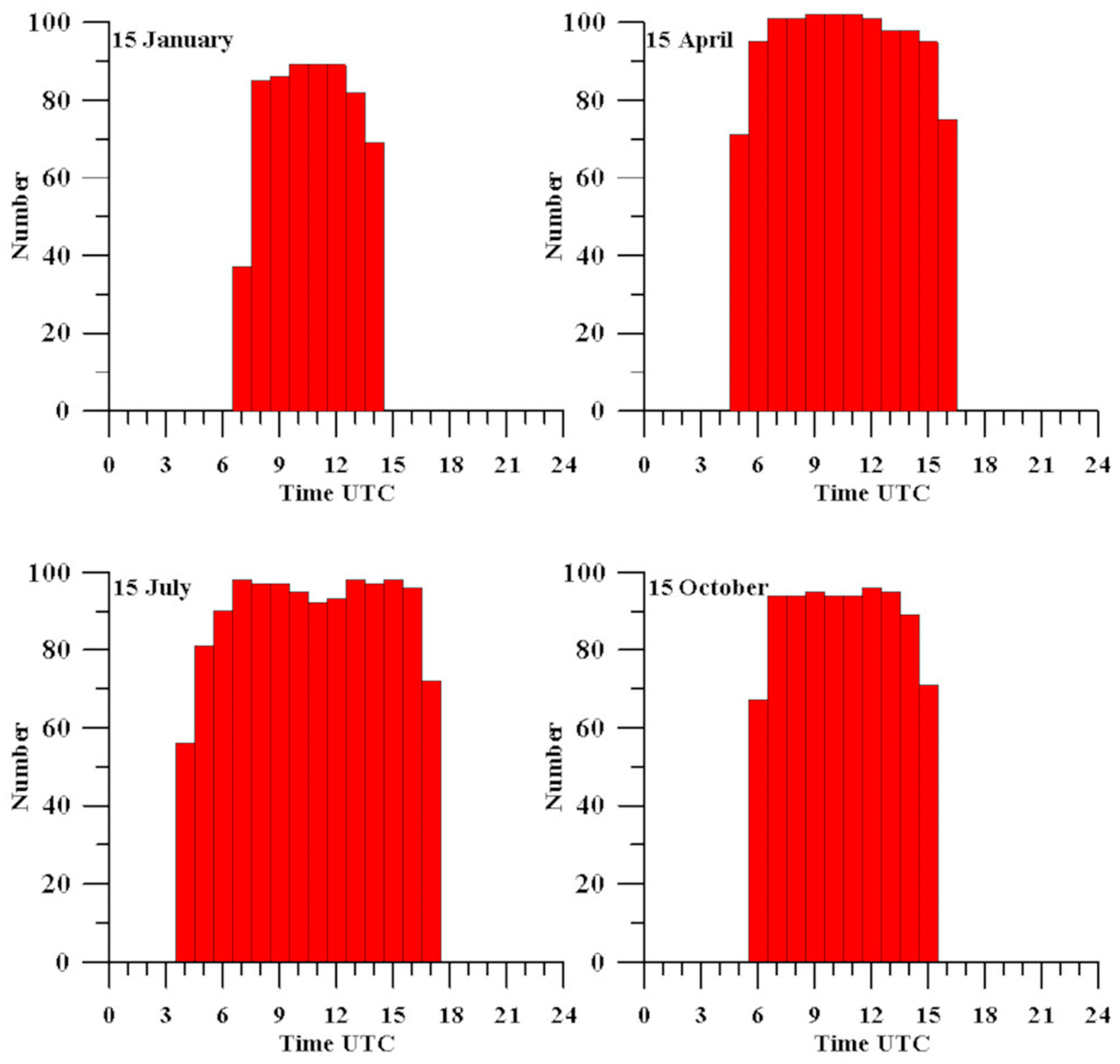
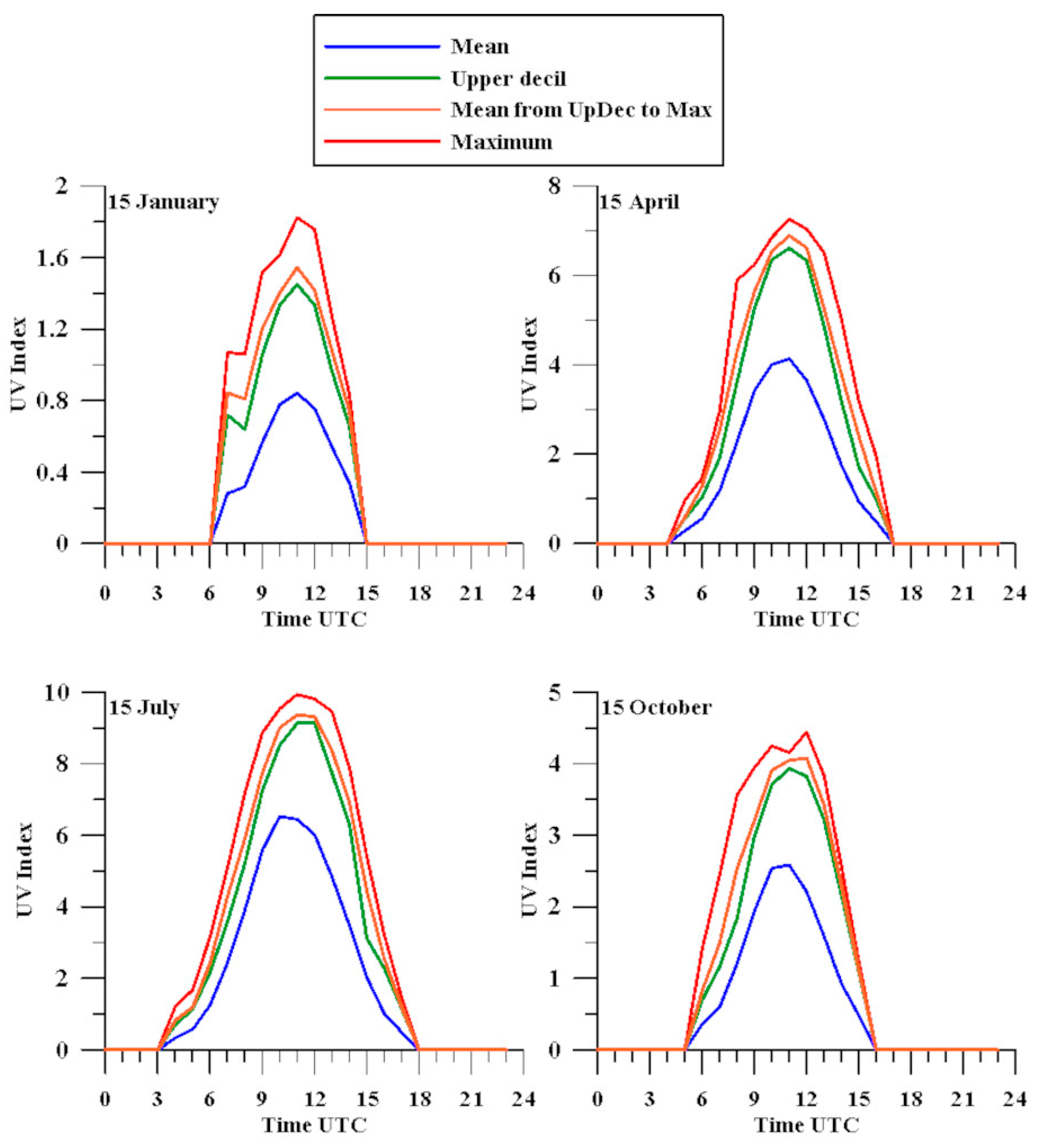
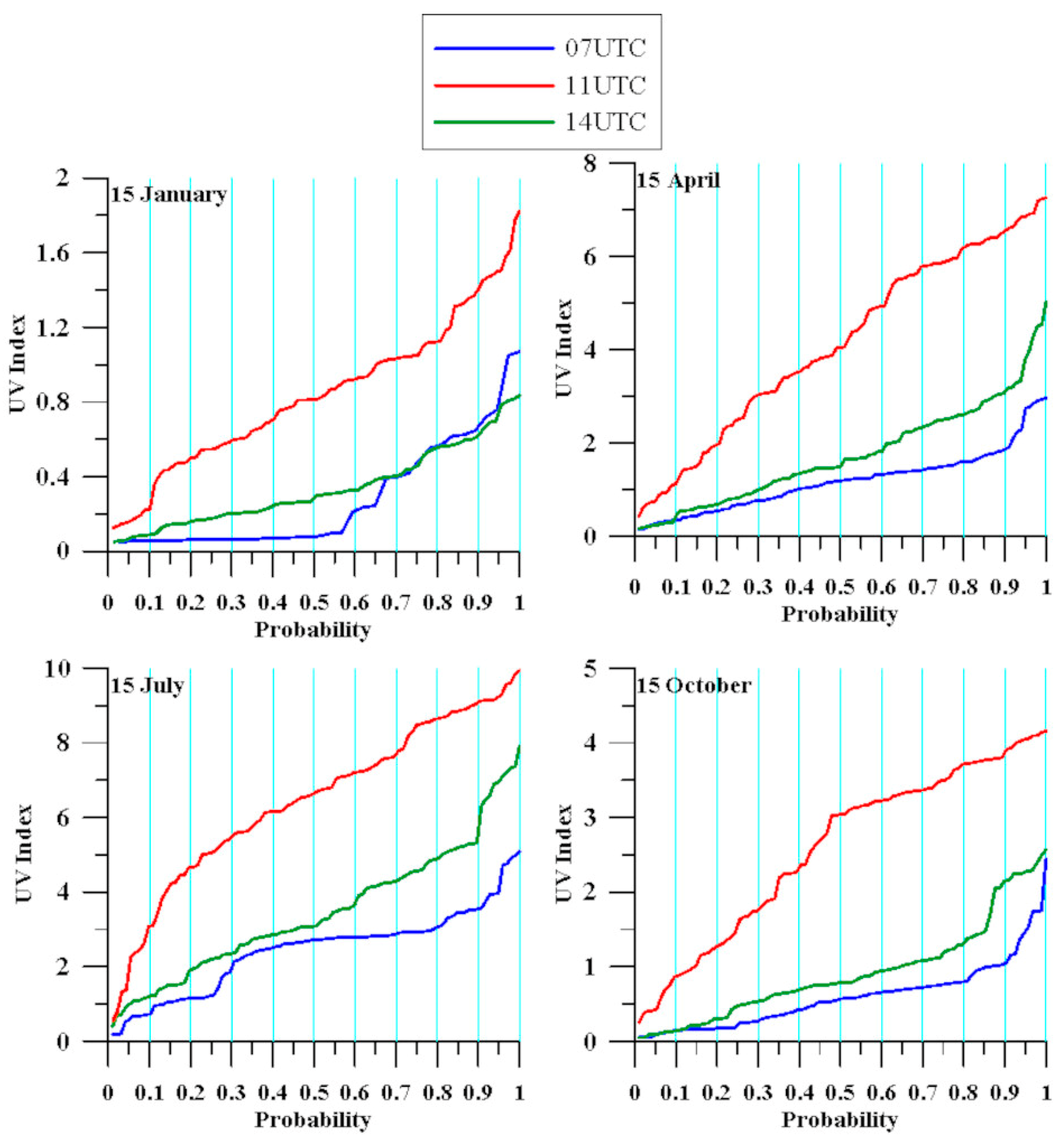
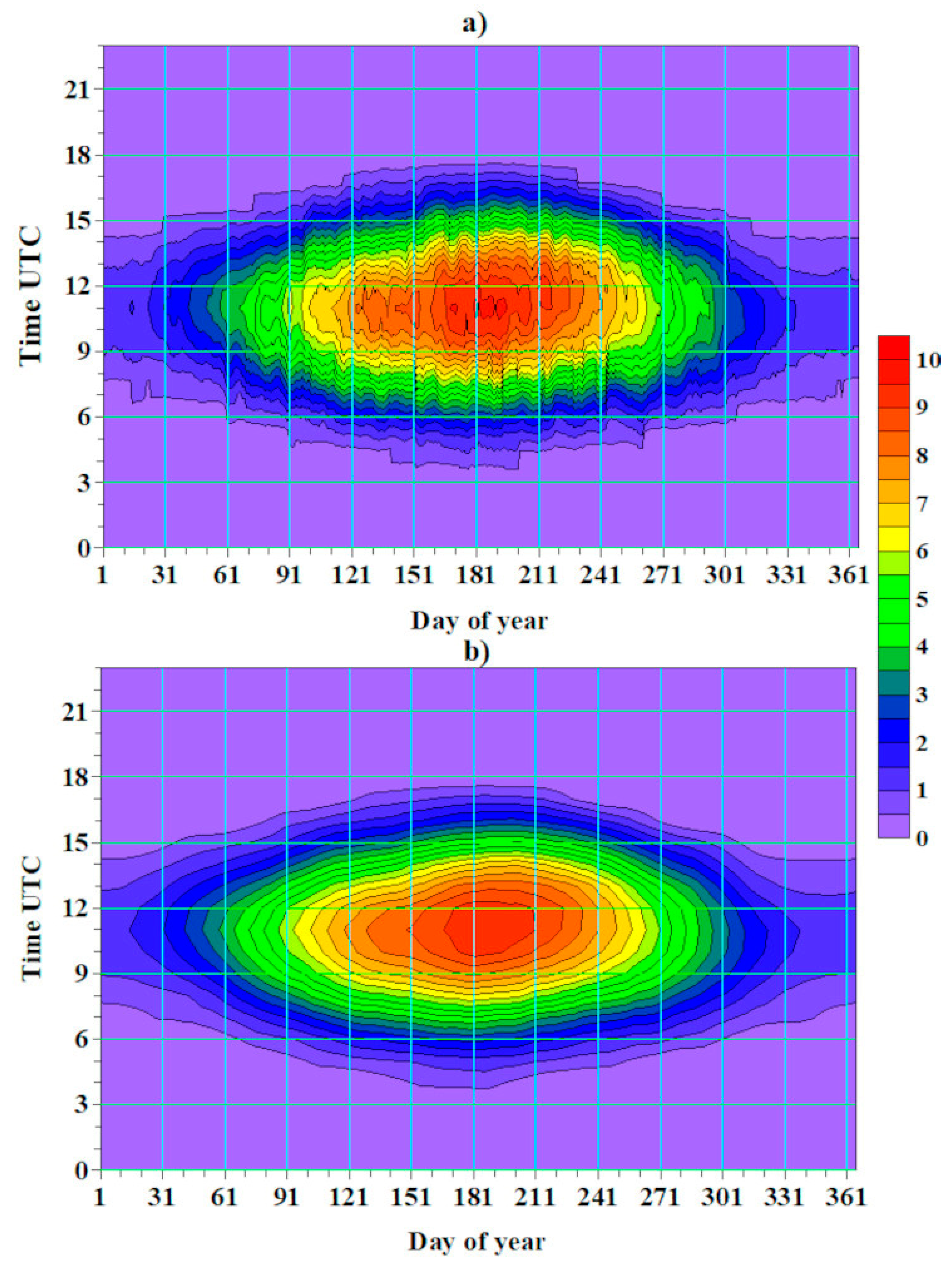
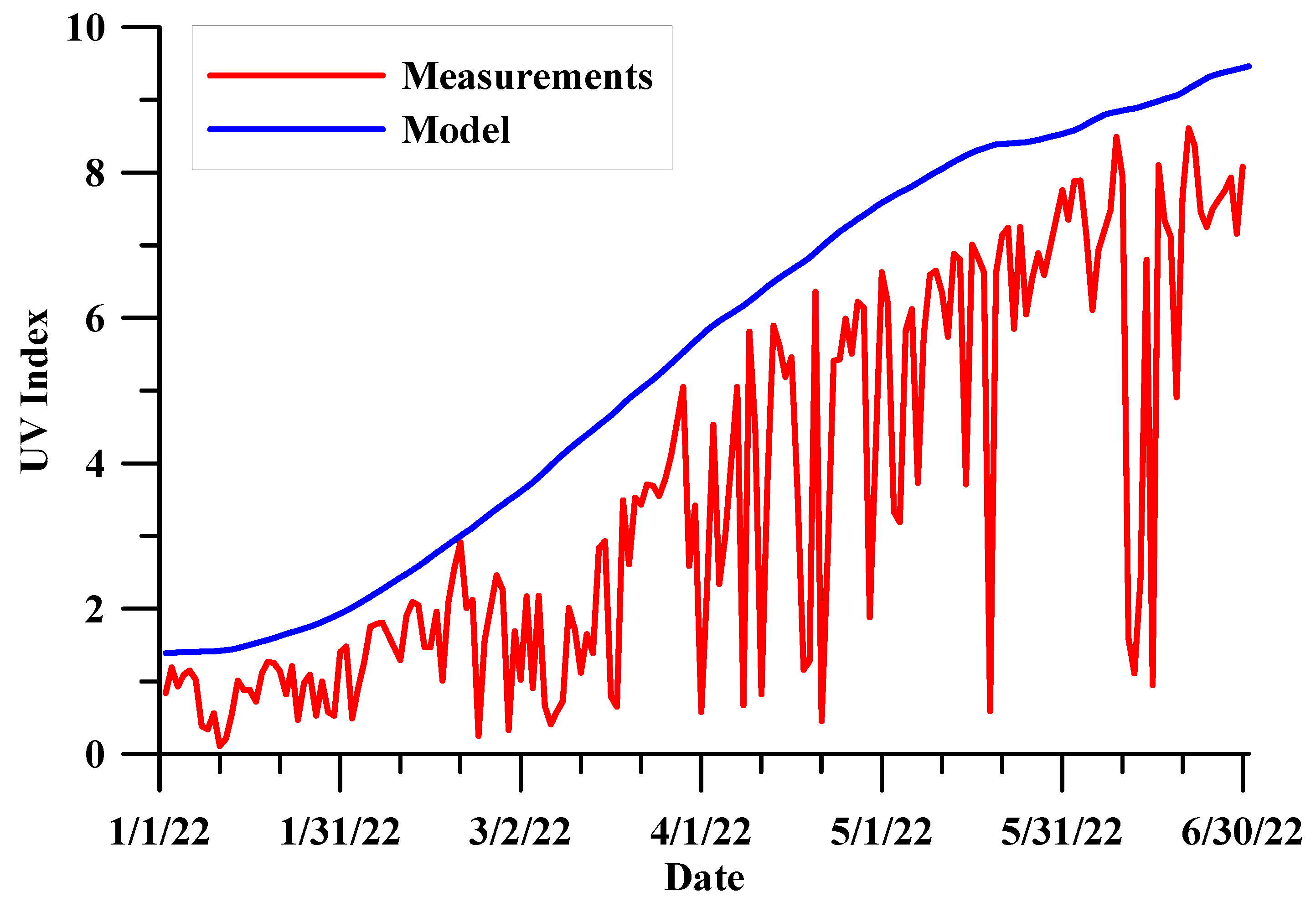
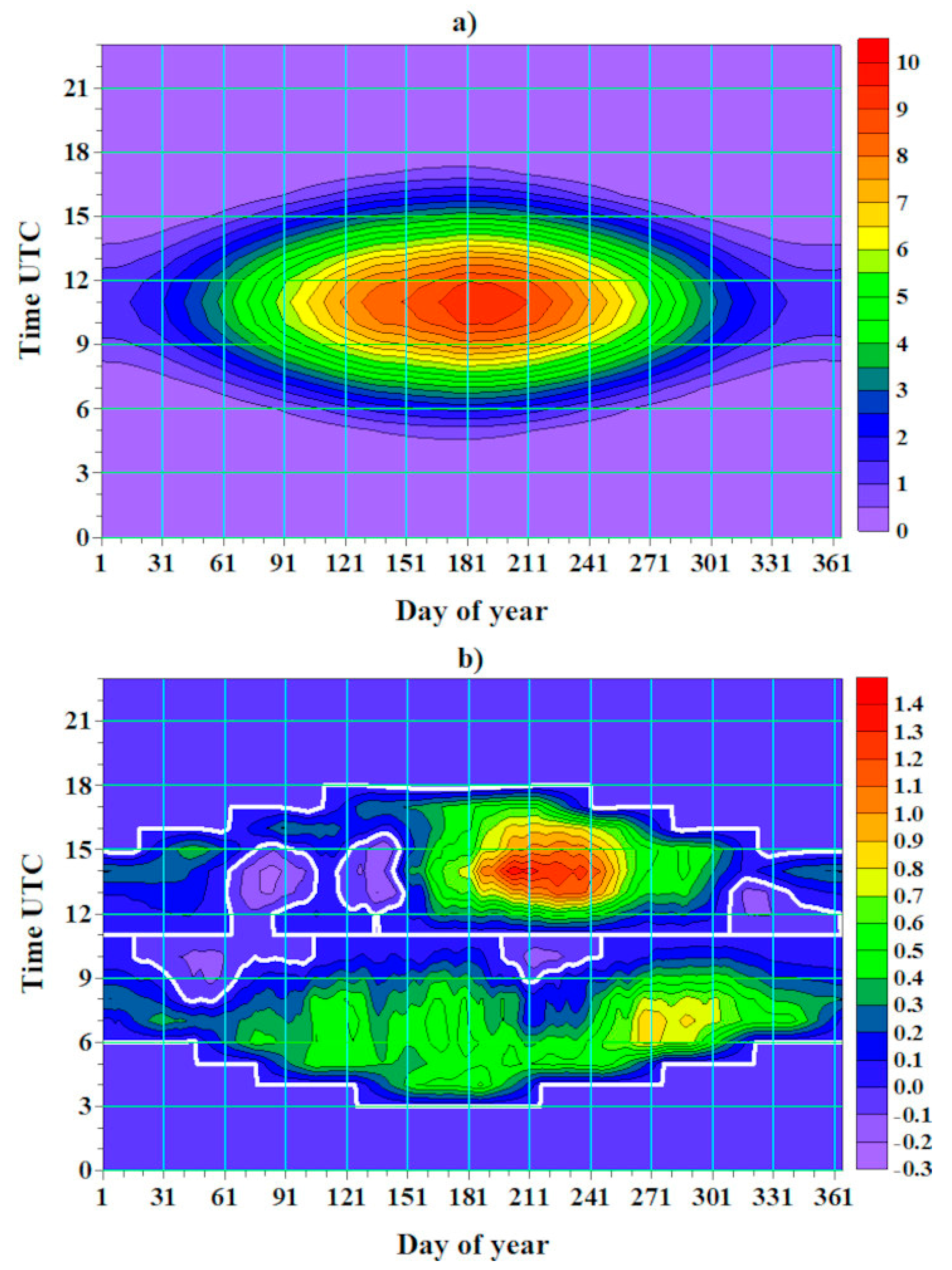
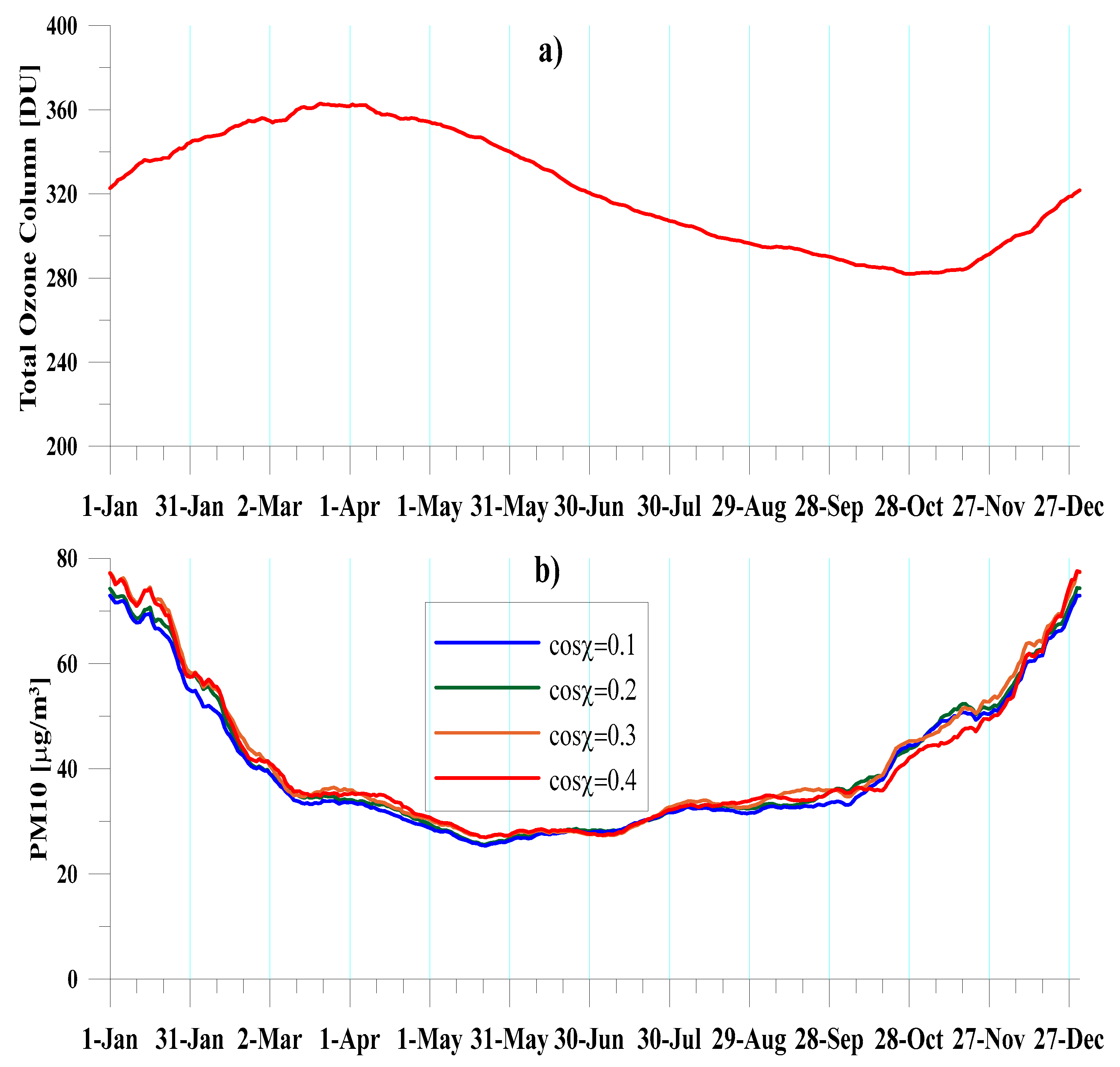
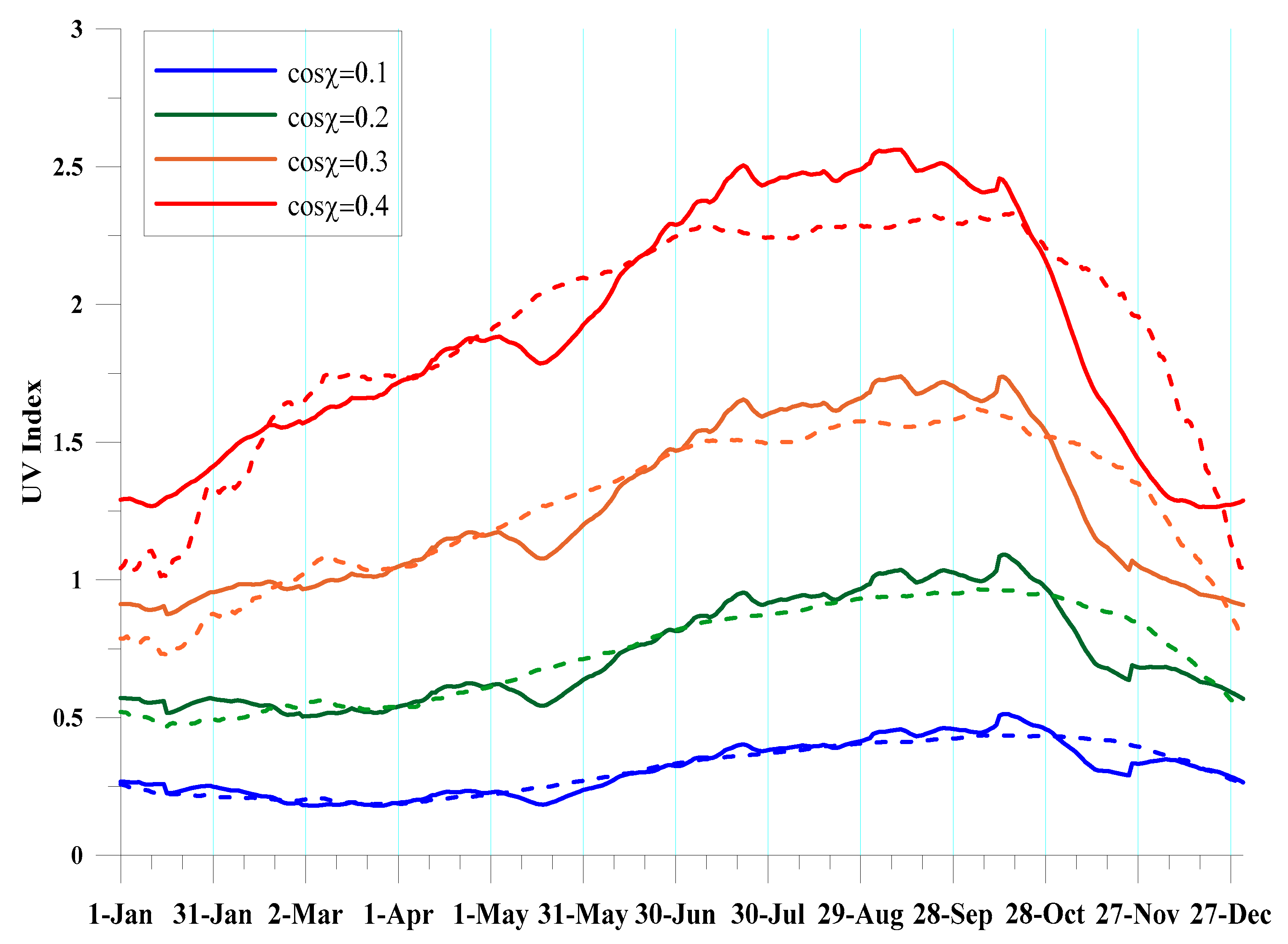
| cosχ | a (TOC) | b (PM10) | c |
|---|---|---|---|
| 0.1 | −0.00329 | −0.00150 | 1.42798 |
| 0.2 | −0.00586 | −0.00616 | 2.87053 |
| 0.3 | −0.00754 | −0.01330 | 4.24745 |
| 0.4 | −0.00791 | −0.02397 | 5.44401 |
Publisher’s Note: MDPI stays neutral with regard to jurisdictional claims in published maps and institutional affiliations. |
© 2022 by the authors. Licensee MDPI, Basel, Switzerland. This article is an open access article distributed under the terms and conditions of the Creative Commons Attribution (CC BY) license (https://creativecommons.org/licenses/by/4.0/).
Share and Cite
Bojilova, R.; Mukhtarov, P.; Miloshev, N. Dependence of the Index of Biologically Active Ultraviolet Radiation on the Season and Time of Day. Atmosphere 2022, 13, 1455. https://doi.org/10.3390/atmos13091455
Bojilova R, Mukhtarov P, Miloshev N. Dependence of the Index of Biologically Active Ultraviolet Radiation on the Season and Time of Day. Atmosphere. 2022; 13(9):1455. https://doi.org/10.3390/atmos13091455
Chicago/Turabian StyleBojilova, Rumiana, Plamen Mukhtarov, and Nikolay Miloshev. 2022. "Dependence of the Index of Biologically Active Ultraviolet Radiation on the Season and Time of Day" Atmosphere 13, no. 9: 1455. https://doi.org/10.3390/atmos13091455
APA StyleBojilova, R., Mukhtarov, P., & Miloshev, N. (2022). Dependence of the Index of Biologically Active Ultraviolet Radiation on the Season and Time of Day. Atmosphere, 13(9), 1455. https://doi.org/10.3390/atmos13091455







